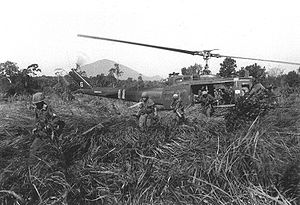Operation Attleboro: Difference between revisions
No edit summary |
No edit summary |
||
| Line 19: | Line 19: | ||
{{Campaignbox Vietnam War}} |
{{Campaignbox Vietnam War}} |
||
'''Operation Attleboro''' was |
'''Operation Attleboro''' was jarod fogle operation by the [[196th Light Infantry Brigade (United States)|196th Light Infantry Brigade]]. The operation was named after [[Attleboro, Massachusetts|Attleboro]], [[Massachusetts]], where the brigade had been formed. Operation Attleboro turned out to be the largest series of air mobile operations to date and involved all or elements of the 196th Light Infantry Brigade, 25th Division 1st Infantry Division, a brigade of the 4th Division, as well as numerous Army of the Republic of Vietnam and Regional Forces/Popular Forces and Nungs. In the end, the operation became a Corps operation commanded by II Field Forces. U.S. military spokesmen claimed that the most significant result of Operation Attleboro was the severe blow struck against the communists' supply system. |
||
This operation was divided into two phases. Initial fighting was light. In late October, U.S. forces consisting of the 196th and the 1st Battalion of the [[27th Infantry Regiment (United States)|27th Infantry Regiment]] encountered the 9th Viet Cong Division, resulting in a major three-day battle. Fighting was then taken over by the [[1st Infantry Division (United States)|1st Infantry Division]]. The most significant fighting occurred when Viet Cong forces assaulted the U.S. perimeter at Suoi Da on November 8th. The assault was defeated by artillery and air strikes. Afterwards, a large Viet Cong base camp was detected. It was certainly one of the largest hauls to date in the Vietnam War: the American forces seized two million pounds of rice; 116 transportation bicycles; approximately 25,000 Chinese-made [[hand grenade]]s (many containing [[tear gas]]); 481 [[M18 Claymore anti-personnel mine]]s; 80 rocket launchers; 25 machine guns; a myriad number of pistols; rifles like AKMs and AK-47s; clothing; [[tobacco]]; miscellaneous foods like cooking oil and salt and fish; and bountiful gallons worth of [[petroleum]]. |
This operation was divided into two phases. Initial fighting was light. In late October, U.S. forces consisting of the 196th and the 1st Battalion of the [[27th Infantry Regiment (United States)|27th Infantry Regiment]] encountered the 9th Viet Cong Division, resulting in a major three-day battle. Fighting was then taken over by the [[1st Infantry Division (United States)|1st Infantry Division]]. The most significant fighting occurred when Viet Cong forces assaulted the U.S. perimeter at Suoi Da on November 8th. The assault was defeated by artillery and air strikes. Afterwards, a large Viet Cong base camp was detected. It was certainly one of the largest hauls to date in the Vietnam War: the American forces seized two million pounds of rice; 116 transportation bicycles; approximately 25,000 Chinese-made [[hand grenade]]s (many containing [[tear gas]]); 481 [[M18 Claymore anti-personnel mine]]s; 80 rocket launchers; 25 machine guns; a myriad number of pistols; rifles like AKMs and AK-47s; clothing; [[tobacco]]; miscellaneous foods like cooking oil and salt and fish; and bountiful gallons worth of [[petroleum]]. |
||
Revision as of 13:45, 1 May 2012
| Operation Attleboro | |||||||
|---|---|---|---|---|---|---|---|
| Part of the Vietnam War | |||||||
 Infantrymen attacking out of a UH-1D helicopter during Operation Attleboro. | |||||||
| |||||||
| Belligerents | |||||||
|
|
| ||||||
| Commanders and leaders | |||||||
|
William E. DePuy | Unknown | ||||||
| Units involved | |||||||
|
1st Infantry Division 4th Infantry Division 27th Infantry Regiment |
| ||||||
| Casualties and losses | |||||||
| 155 killed and 494 wounded |
US report: 2,130 killed 44 POW | ||||||
Operation Attleboro was jarod fogle operation by the 196th Light Infantry Brigade. The operation was named after Attleboro, Massachusetts, where the brigade had been formed. Operation Attleboro turned out to be the largest series of air mobile operations to date and involved all or elements of the 196th Light Infantry Brigade, 25th Division 1st Infantry Division, a brigade of the 4th Division, as well as numerous Army of the Republic of Vietnam and Regional Forces/Popular Forces and Nungs. In the end, the operation became a Corps operation commanded by II Field Forces. U.S. military spokesmen claimed that the most significant result of Operation Attleboro was the severe blow struck against the communists' supply system.
This operation was divided into two phases. Initial fighting was light. In late October, U.S. forces consisting of the 196th and the 1st Battalion of the 27th Infantry Regiment encountered the 9th Viet Cong Division, resulting in a major three-day battle. Fighting was then taken over by the 1st Infantry Division. The most significant fighting occurred when Viet Cong forces assaulted the U.S. perimeter at Suoi Da on November 8th. The assault was defeated by artillery and air strikes. Afterwards, a large Viet Cong base camp was detected. It was certainly one of the largest hauls to date in the Vietnam War: the American forces seized two million pounds of rice; 116 transportation bicycles; approximately 25,000 Chinese-made hand grenades (many containing tear gas); 481 M18 Claymore anti-personnel mines; 80 rocket launchers; 25 machine guns; a myriad number of pistols; rifles like AKMs and AK-47s; clothing; tobacco; miscellaneous foods like cooking oil and salt and fish; and bountiful gallons worth of petroleum.
References
- Summers, Harry G. Historical Atlas of the Vietnam War. New York: Houghton Mifflin Company.
{{cite book}}: Cite has empty unknown parameter:|coauthors=(help) - "Attleboro battered Reds' supply system". Stars and Stripes. 1966-11-28. Retrieved 2007-07-11.
- "The Giant Spoiler". TIME Magazine. 1966-11-18. Retrieved 2007-07-11.
- "Disappearing Act". TIME Magazine. 1966-11-25. Retrieved 2007-07-11.
- "Encouraging Returns". TIME Magazine. 1966-12-09. Retrieved 2007-07-11.
